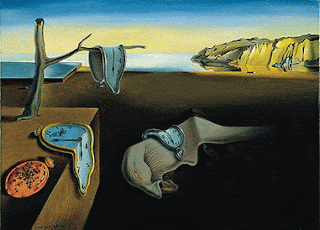Because we know so little about dreams, artists have a huge
amount of room to use their imagination and get creative (Professor
Vesna). Some people use dreams as
a way of escaping reality and others simply use dreams to explore their
imagination (Real Meaning of Dreams).
Heavily influenced by Sigmund Freud’s ideas of the
unconscious, the Surrealist movement inspired artists to incorporate dreams and
the unconscious in their work. One
of the most famous artists whose work depicted a dream like scene was Salvador
Dali’s The Persistence of Memory. “One can see through his artwork Dali’s
fascination with the fleeting state of mind between sleep and consciousness,
dream and reality, sanity and insanity” (Real Meaning of Dreams).
Through his painting it is easy to tell that dreams open up artists’
imaginations and allow them to expand their creativity and create artwork that
is technically unrealistic.
Another art form that incorporates dreams and the unconscious is in
the film industry. One recent,
popular film called Inception by
Christopher Nolan was based off of the idea of a thief who infiltrates the
subconscious of people to learn their secrets.
I think the reason why the unconscious and dreams are such popular
themes among movies and artists is because we are fascinated by the endless
possibilities that the idea of dreams and the unconscious give us. There is so much room for creativity
and imagination within those ideas that the directions in which they can be
used are limitless. Not only do dreams
captivate people and intrigue audiences, but they allow artists ways to create
unique masterpieces.
"Dream Art and Creativity." Dream Art and Creativity. N.p., 2007. Web. 18 May 2015. <http://www.realmeaningofdreams.com/dream-art.html>.
"2 / Dreams and Visions." Art Through Time: A Global View. Annenburg Foundation, 2015. Web. 18 May 2015. <http://learner.org/courses/globalart/theme/2/index.html>.
Gregoire, Carolyn. "8 Famous Ideas That Came From Dreams (Literally)." The Huffington Post. TheHuffingtonPost.com, 16 Nov. 2013. Web. 18 May 2015. <http://www.huffingtonpost.com/2013/11/16/famous-ideas-from-dreams_n_4276838.html>.
"Inception." Wikipedia. Wikimedia Foundation, n.d. Web. 18 May 2015. <http://en.wikipedia.org/wiki/Inception>.
Vesna, Victoria. "Art and Neuroscience Part 2." YouTube. YouTube, 17 May 2012. Web. 18 May 2015. <https://www.youtube.com/watch?v=TFv4owX3MZo>.



Dreams are a curious thing. Similar to some aspects of Inception, some people can lucid dream, or make choices in their dream that define how it progresses. It would be interesting to see how the neurological brain waves of someone is different between lucid dreaming, normal dreaming, and no dreaming at all. Some say you can practice to able to lucid dream and it would be interesting to see how the brain is different between dreaming.
ReplyDelete